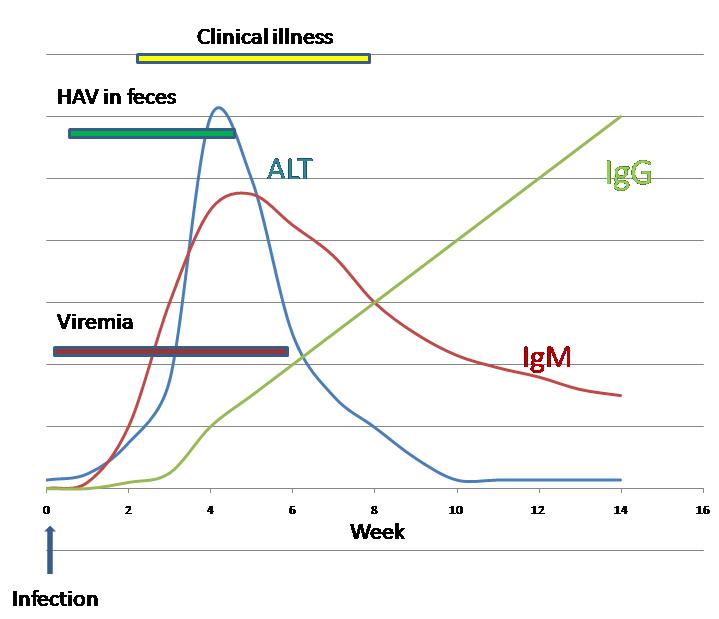Hepatitis A laboratory findings: Difference between revisions
Joao Silva (talk | contribs) |
Joao Silva (talk | contribs) |
||
| Line 4: | Line 4: | ||
==Overview== | ==Overview== | ||
[[Hepatitis A]] cannot be differentiated from other types of [[viral hepatitis]] on the basis of clinical or [[epidemiologic]] features alone. Laboratory tests are required for its [[diagnosis]] | [[Hepatitis A]] cannot be differentiated from other types of [[viral hepatitis]] on the basis of clinical or [[epidemiologic]] features alone. Laboratory tests are required for its [[diagnosis]]. These include: [[serologic]] tests, showing elevated [[IgM]] anti-[[HAV]] in the acute phase (gold standard), and an elevated [[IgG]] anti-[[HAV]], which remains elevated for the person's lifetime; [[HAV]] [[RNA]] detection and sequencing; and elevated direct [[bilirubin]] and [[liver enzymes]], such as [[aminotransferase]] and [[alkaline phosphatase]]. [[Liver biopsy]] has a minimal role in the [[diagnosis]] of [[HAV infection]], being used in cases where the [[diagnosis]] is unclear or there is suspicion of relapse. | ||
==Laboratory Findings== | ==Laboratory Findings== | ||
Revision as of 15:58, 28 July 2014
|
Hepatitis A |
|
Diagnosis |
|
Treatment |
|
Case Studies |
|
Hepatitis A laboratory findings On the Web |
|
American Roentgen Ray Society Images of Hepatitis A laboratory findings |
|
Risk calculators and risk factors for Hepatitis A laboratory findings |
Editor-In-Chief: C. Michael Gibson, M.S., M.D. [1]; Associate Editor(s)-in-Chief: João André Alves Silva, M.D. [2]
Overview
Hepatitis A cannot be differentiated from other types of viral hepatitis on the basis of clinical or epidemiologic features alone. Laboratory tests are required for its diagnosis. These include: serologic tests, showing elevated IgM anti-HAV in the acute phase (gold standard), and an elevated IgG anti-HAV, which remains elevated for the person's lifetime; HAV RNA detection and sequencing; and elevated direct bilirubin and liver enzymes, such as aminotransferase and alkaline phosphatase. Liver biopsy has a minimal role in the diagnosis of HAV infection, being used in cases where the diagnosis is unclear or there is suspicion of relapse.
Laboratory Findings
Serologic Tests
Serologic testing to detect immunoglobulin M (IgM) antibody to the capsid proteins of HAV (IgM anti-HAV) is required to confirm the diagnosis of acute HAV infection.
- Immunoglobulin M (IgM) anti-HAV:[1][2]
- Gold standard for the detection of acute illness
- In most persons, it becomes detectable 5-10 days before the onset of symptoms and can persist for up to 6 months after infection
- Presence of serum IgM anti-HAV antibodies in asymptomatic adults does not indicate acute infection. It may occur in the following cases:
- Previous HAV infection with prolonged presence of IgM anti-HAV
- False-positive result
- Asymptomatic infection (more common in children)
- Immunoglobulin G (IgG) anti-HAV:[3]
- Appears early in the course of infection
- Remains detectable for the person's lifetime
- Confers lifelong protection against the disease
Two serologic tests are licensed for the detection of antibodies to HAV:
In the majority of patients, IgM anti-HAV declines to undetectable levels less than 6 months after infection. However, persons who test positive for IgM anti-HAV, more than 1 year after infection have been reported, as have likely false-positive tests in persons without evidence of recent HAV infection.
Total anti-HAV testing is used in epidemiologic studies to measure the prevalence of previous infection or by clinicians to determine whether a person with an indication for pre-exposure prophylaxis is already immune.
Sensitive tests for immunoglobulin M (IgM) and immunoglobulin G (IgG) anti-HAV in saliva have been developed but are not licensed in the United States.
Electron Microscopy
- HAV RNA can be detected in the blood and stool of the majority of persons during the acute phase of infection by using nucleic acid amplification methods.
- Nucleic acid sequencing has been used to determine the relatedness of HAV isolates for epidemiologic investigations. However, only a limited number of research laboratories have the capacity to use these methods, which makes them not commonly used in the diagnosis of HAV infection.[4]
Liver Function Tests
Liver enzymes such as aminotransferase and alkaline phosphatase, along with direct bilirubin are commonly elevated among patients with Hepatitis A[5]:
- The serum levels of alanine aminotransferase (ALT) are usually higher than aspartate aminotransferase (AST)
- Bilirubin levels tends to increase after the elevation of serum aminotransferase
Other Laboratory Findings
- Acute phase reactants, such as PCR and erythrocyte sedimentation rate (ESR) are commonly elevated.

Liver Biopsy
The role of a liver biopsy is minimal in the diagnosis of hepatitis A. It may be used in cases involving chronic relapsing hepatitis A or when the diagnosis is unclear.
References
- ↑ Bower WA, Nainan OV, Margolis HS. Duration of viremia in naturally-acquired hepatitis A viral infections. [Abstract 103] In: Abstracts of the Infectious Diseases Society of America 35th Annual Meeting. Alexandria, VA: Infectious Diseases Society of America, 1997.
- ↑ Liaw YF, Yang CY, Chu CM, Huang MJ (1986). "Appearance and persistence of hepatitis A IgM antibody in acute clinical hepatitis A observed in an outbreak". Infection. 14 (4): 156–8. PMID 3759243.
|access-date=requires|url=(help) - ↑ Stapleton JT (1995). "Host immune response to hepatitis A virus". The Journal of Infectious Diseases. 171 Suppl 1: S9–14. PMID 7876654. Retrieved 2012-02-28. Unknown parameter
|month=ignored (help) - ↑ Hutin YJ, Pool V, Cramer EH, Nainan OV, Weth J, Williams IT, Goldstein ST, Gensheimer KF, Bell BP, Shapiro CN, Alter MJ, Margolis HS (1999). "A multistate, foodborne outbreak of hepatitis A. National Hepatitis A Investigation Team". The New England Journal of Medicine. 340 (8): 595–602. doi:10.1056/NEJM199902253400802. PMID 10029643. Retrieved 2012-02-28. Unknown parameter
|month=ignored (help) - ↑ Tong MJ, el-Farra NS, Grew MI (1995). "Clinical manifestations of hepatitis A: recent experience in a community teaching hospital". The Journal of Infectious Diseases. 171 Suppl 1: S15–8. PMID 7876641. Retrieved 2012-03-08. Unknown parameter
|month=ignored (help)